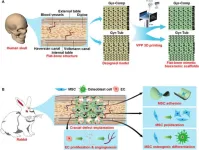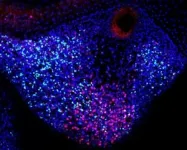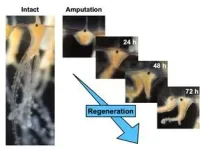3D-printed flat-bone-mimetic bioceramic scaffolds for cranial restoration
2023-12-22
(Press-News.org)
The cranial bone in the human body performs very important functions, such as protecting the brain and enabling the passage of the cranial nerves that are essential to physiological functioning. Critical-sized cranial defects can disrupt both the physical and psychological well-being of patients. Restoration of critical-sized cranial defects by cranioplasty is challenging for reconstructive surgeons, who prefer to use autologous bone grafts. The acquisition of autologous bone requires additional surgeries concomitant with risks such as free flap loss, infection, deep venous thrombosis, and nerve injury. These limitations necessitate the development of alternatives to autologous bone grafts for cranial defect restoration.
Biomaterials mimicking the composition and microstructure of natural bone are widely acknowledged to be ideal for bone defect regeneration The cranial bones are mainly composed of calcium phosphate, and they are typical flat bones, which are generally thin and broad with a flattened or curved surface. The flat bone has two outer compact tables made of cortical bone. The region between the two tables is called the diploe, which is composed of cancellous bone. Cortical bone has low porosity (5% to 10%) with interconnected tube-like pores, which are called Haversian canals and Volkmann canals. The cancellous bone is composed of irregular sponge-like trabeculae with a high specific surface area, and the mean surface curvature of the trabeculae surface is close to zero. The architectural characteristics of cancellous bone are similar to those of gyroid-type triply periodic minimal surface (TMPS) pore topology.
Inspired by the composition and structural features of cranial bones, scientists from South China University and Technology developed two flat-bone-mimetic β-tricalcium phosphate bioceramic scaffolds (Gyr-Comp and Gyr-Tub) by high-precision vat photopolymerization-based 3D printing. Both scaffolds had two outer layers and an inner layer with gyroid pores mimicking the diploe structure. The outer layers of Gyr-Comp scaffolds simulated the low porosity of outer tables, while those of Gyr-Tub scaffolds mimicked the tubular pore structure in the tables of flat bones. The Gyr-Comp and Gyr-Tub scaffolds possessed higher compressive strength and noticeably promoted in vitro cell proliferation, osteogenic differentiation and angiogenic activities compared with conventional scaffolds with cross-hatch structures. After implantation into rabbit cranial defects for 12 weeks, Gyr-Tub achieved the best repairing effects by accelerating the generation of bone tissues and blood vessels. The Gyr-Tub scaffolds have high prospects for treating cranial bone defects in clinical applications. This work provides an advanced strategy to prepare biomimetic biomaterials that fit the structural and functional needs of efficacious bone regeneration.
END
ELSE PRESS RELEASES FROM THIS DATE:
2023-12-22
P. Hemachandra Reddy, Ph.D., a professor in the Texas Tech University Health Sciences Center (TTUHSC) School of Medicine’s Department of Internal Medicine who has researched healthy aging, dementia and other neurodegenerative diseases for more than 20 years, recently was named to the 2023 class of Fellows for the National Academy of Inventors (NAI).
The NAI is a member organization comprised of U.S. and international universities and governmental and nonprofit research institutes with more than 4,600 individual inventor members and fellows spanning more than 300 institutions worldwide. ...
2023-12-22
Vision is a complex process. The visual perception of the environment is created by a combination of different wavelengths of light, which are decoded as colours and brightness in the brain. Photoreceptors in the retina first convert the light into electrical impulses: with sufficient light, the cones enable sharp, detailed, and coloured vision. Rods only contribute to vision in low light conditions allowing for different shades of grey to be distinguished but leaving vision much less precise. The electrical nerve impulses are finally transmitted to ganglion cells in the retina and then via the optic nerve to the visual cortex in the ...
2023-12-22
Imagine a flying dragon that doesn’t spout fire, but instead extinguishes it with blasts of water. Thanks to a team of Japanese researchers, this new kind of beast may soon be recruited to firefighter teams around the world, to help put out fires that are too dangerous for their human teammates to approach.
The blueprint of this novel firefighter robot, called the Dragon Firefighter, has now been published in Frontiers in Robotics and AI. And as it has been published as Open Science, roboticists around the world may freely ...
2023-12-21
CORNELL UNIVERSITY MEDIA RELATIONS OFFICE
FOR RELEASE: Dec. 21, 2023
Kaitlyn Serrao
607-882-1140
kms465@cornell.edu
ITHACA, N.Y. – Cornell researchers partnered with New York livestock farmers to analyze transactions at farmers markets, finding that sales were better on Sundays, early in the morning, and during certain months of the year. The study, which researchers believe is the first peer-reviewed analysis of customer-level transaction data at farmers markets, gives new insights into how farmers can make markets more profitable for them.
The researchers and farmers used point-of-sale devices that record sales ...
2023-12-21
Less than half of patients with malignant ureteral obstruction (MUO) – a serious complication of advanced cancer, with a poor prognosis – receive palliative care (PC) for their condition, reports a paper in the January issue of Urology Practice®, an Official Journal of the American Urological Association (AUA). The journal is published in the Lippincott portfolio by Wolters Kluwer.
Hospice care can promote patient comfort while avoiding aggressive and invasive treatments for MUO patients nearing the end ...
2023-12-21
December 7, 2023 —The Journal of Continuing Education in the Health Professions (JCEHP) has published a supplement, "Conceptual Advances in Continuing Professional Development in the Health Professions," in which scholars of continuing professional development (CPD) creatively examine prevailing assumptions and propose new theoretical frameworks and empirical insights. Publication of the supplemental issue is supported by the Society for Academic Continuing Medical Education (SACME). JCEHP, the official journal of the Alliance for Continuing Education in the Health Professions, ...
2023-12-21
Researchers at the UCLA Health Jonsson Comprehensive Cancer Center have received a five-year, $3 million grant from the National Cancer Institute to identify novel cancer biomarkers and develop AI that can detect and predict aggressive prostate cancer to help avoid unnecessary treatments and their associated negative side effects.
Despite recent advancements, prostate cancer remains a common and serious health issue for men, and current methods of screening and risk assessment can often lead to overdiagnosis and overtreatment. About 90% of people diagnosed with prostate cancer receive treatment, even though ...
2023-12-21
Through an international collaboration, scientists at St. Jude Children’s Research Hospital leveraged data science, pharmacology and structural information to conduct an atomic-level investigation into how each amino acid in the receptor that binds adrenaline contributes to receptor activity in the presence of this natural ligand. They discovered precisely which amino acids control the key pharmacological properties of the ligand. The adrenaline receptor studied is a member of the G protein-coupled receptor (GPCR) family, and this family is the target of one-third of all Food and Drug Administration (FDA)-approved drugs. Thus, understanding how ...
2023-12-21
Scientists at St. Jude Children’s Research Hospital revealed the complex structure of two Parkinson’s disease-related proteins, both of which are implicated in late-onset cases. Leucine-rich repeat kinase 2 (LRRK2) is a protein kinase that modifies other proteins in a process called phosphorylation; Rab29, a member of the Rab GTPase family that regulates cellular trafficking, modulates the activity of LRRK2. How Rab29 and LRRK2 work synergistically to cause Parkinson’s disease remains ...
2023-12-21
Doctors diagnosed Christopher Gregg, Ph.D., member of the Nuclear Control of Cell Growth and Differentiation Program at Huntsman Cancer Institute at the University of Utah (the U) and neuroscientist and professor of neurobiology and human genetics at the U, with stage 4 metastatic breast cancer in 2018. At that point, he started thinking of ways to improve his treatment.
“The core problem of metastatic cancer is it evolves,” says Gregg. “There may be a treatment that works today but eventually ...
LAST 30 PRESS RELEASES:
[Press-News.org] 3D-printed flat-bone-mimetic bioceramic scaffolds for cranial restoration







